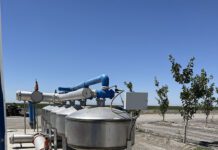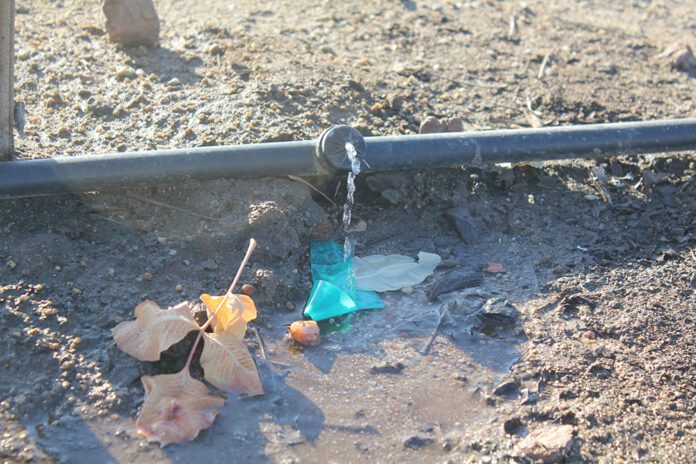
In the early, nonbearing years, an orchard’s long-term health can be affected by overirrigation or underirrigation. Recognizing small canopies and small root systems have limited uptake capacity is important in irrigation management. Their water needs will change as canopies and root systems expand.
Knowing the application rate of your irrigation system and the water holding capacity of the soil type in the orchard, a grower or farm manager can calculate the maximum amount of time between irrigations.
Irrigation scheduling can be soil-based, plant-based or weather-based, but to minimize overwatering or underwatering young orchards, a combination of those methods is recommended. At a UCCE workshop on irrigating young orchards, Charles Hillyer, director of the Center for Water Technology at Fresno State, noted in irrigation management of young orchards, the idea is to correctly determine how much and when to apply water.
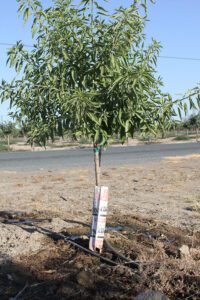
The water holding capacity of any-age orchard depends on soil type and texture. Recognizing the limiting factors in an orchard’s soil type can help with irrigation scheduling. Different soil types have different water holding capacities that can range from 0.4 inches of water per foot of soil in coarse sandy soils to 2.50 inches of water per foot of soil in silty clay soils.
Cameron Zuber, UCCE orchard systems advisor in Merced County, said determining when to begin irrigating is the first step in irrigating young trees. How much water the trees are using and how much water the soil can hold should be calculated. Next, check to see if your calculation of tree use is correct. In almonds, Zuber said first-leaf trees use about 40% of the evapotranspiration (ET) for mature trees. Second-leaf trees use 55%, third-leaf trees use 75% and fourth-leaf trees use 90%.
There is no perfect tool to check if water application is right, Zuber said, but he advised growers and irrigators to select a tool that works for them. Calculating the water application rate of the system can be done knowing how many gallons each drip emitter or microsprinkler puts out per hour.
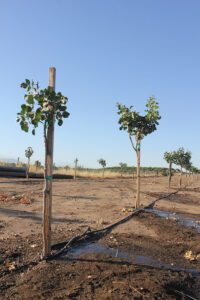
Pistachio Trees
Getting started with young pistachio tree irrigation management is a little different. Tobias Oker, UCCE irrigation and soils management advisor in Kern County, said there is a strong linear relationship between canopy shading and ET in pistachios. Salinity issues with water and/or soil can make a difference in irrigation. The weekly ET in the southern San Joaquin Valley for a one-year-old pistachio tree with a 5% canopy is 0.5. At a 10% canopy, ET goes to 1.0.
Oker noted pistachio tree root systems are deep-rooted. Young pistachio trees have rapid extension of seminal pivot or tap root and develop a system that moves deep into the soil. Other roots grow more horizontally closer to the surface seeking moisture. In Iran, where pistachio production has a long history, water use is much less and that is reflected in much lower crop yields.
Oker said microirrigation is best for young pistachio trees with emitters that apply water close to the tree right after planting. While the ideal wetting pattern for mature trees is 50% to 60% or a third to a half of the horizontal cross section of the area, young trees need a much smaller wetting pattern.
Oker said to initially position the dripper to apply water directly to the root ball of newly planted trees. It takes about 30 days for the tree roots to grow into the soil mass.
Phoebe Gordon, UCCE orchard crops advisor in Madera County, said overirrigation of young trees can result in disease and poor growth due to less oxygen in the root zone when soil is saturated.
She advised getting data from sensors, ET, sap flow or canopy temperatures to determine when to initiate irrigation but noted tree water status and/or soil moisture conditions are more useful than ET in the first two months after planting trees.
Water should be applied in the root zone, not outside, in young trees. Wetting larger areas than needed increases evaporation losses, promotes weed growth and wastes water. She noted that two 1-gallon-per-hour external emitters placed 10 to 15 inches to each side of the tree provides enough capacity to adequately irrigate newly planted trees. This system should work until the third year when microsprinklers should be installed and the emitters plugged.
As an alternative, microsprinklers can be used but capped to limit the spray radius during the first two years. Caps can be removed, and the sprinklers moved farther from the tree once the trees are growing well and the root system has expanded.
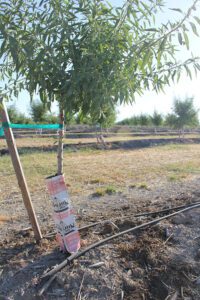
Walnuts
Irrigation strategy in young walnut trees is also a little different than young almond or pistachio trees, Moneim Mohamad, UCCE irrigation and soils advisor in Stanislaus County, said. He did agree with Gordon that tree water status and/or soil moisture conditions are better than ET irrigation scheduling right after planting trees.
To accurately estimate ET for irrigation in young walnuts, he said to consider site-specific conditions, cultivars and rootstock, and orchard floor vegetation. Higher or lower temperatures after planting can slow tree growth, Mohamad noted.
If using ET for scheduling, he said it changes 2% per 1% reduction in canopy shaded area for trees smaller than 20% midday shaded area. After planting, average PAR (photosynthetically active radiation) is 1%. An estimated average canopy of 1% suggests a crop coefficient adjustment of 2%.
A combination of three irrigation scheduling methods is recommended, Mohamad said, as it gives a grower more confidence in making informed and effective water management decisions.
He also cautioned against using a deficit irrigation plan on young walnut trees.

Cecilia Parsons | Associate Editor
Cecilia Parsons has lived in the Central Valley community of Ducor since 1976, covering agriculture for numerous agricultural publications over the years. She has found and nurtured many wonderful and helpful contacts in the ag community, including the UCCE advisors, allowing for news coverage that focuses on the basics of food production.
She is always on the search for new ag topics that can help growers and processors in the San Joaquin Valley improve their bottom line.
In her free time, Cecilia rides her horse, Holly in ranch versatility shows and raises registered Shetland sheep which she exhibits at county and state fairs during the summer.









